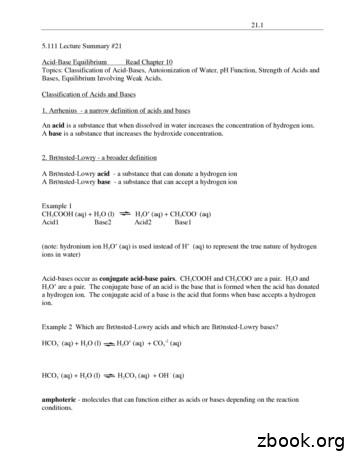Acid & Base - Contents.kocw.or.kr
Acid & Base담당교수: 장선주
Acid - Base HomeostasisPH 7.35-7.45BufferingBicarbonate bufferPhosphate bufferProtein bufferPhysiologiccompensationRespiratory systemKidney system
Acid – Base Homeostasis : Buffer system Buffer system (완충체계) H 를 흡수or 배출하여 일정한 PH유지 Chemical SpongeIntra-cellular BufferPhosphate, ProteinExtra-cellular BufferHCO3-/CO2 systemPlasma protein (alb)
Acid – Base Homeostasis : Buffer systemHCO3-/CO2Phosphate Extracellular Intracellular H2CO3H HCO3- 신장세뇨관에서H 배출 H 의 90% 완충Protein Intracellular/Extracellular 체내에서 가장풍부한 완충
Acid – Base Homeostasis : Compensation CO2 제거 담당 폐포의 환기량 조절 1-3분 정도 소요 H 배설: H2PO4NH4 가장 강력한 방법 수시간 수일 소요
What is ABGA ? Arterial Blood Gas Analysis(동맥혈 가스분석) Radial artery , Femoral artery 등 이용 체내의 정확한 산소화 파악 체내의 산 염기정도 파악 PH - PaCO2 - PaO2 - HCO3- - O2 SAT
ABGA 구성요소PHAcid or BasePaCO2Ventilation statusPaO2, O2 SATOxygenation statusHCO3-, BEMetabolic parameter
ABGA 구성요소 - PH PH [H ] 농도 : 산도(acidity)와 같은 의미 H 농도가 높을수록 산도 증가 PH log1H 농도 -log H 농도 Normal PH 7.40 (7.35 7.45)
ABGA 구성요소 - PH화학적 완충제Buffer system호흡기계 조절RespiratoryH 농도 조절 기전신장의 조절Metabolic
ABGA 구성요소 – PaCO2 PaCO2 CO2 : 세포 대사 산물, 혈액에 녹음 호흡 시 폐를 통하여 제거됨 PaCO2 : CO2의 생성과 제거 균형의 결과 폐포 호흡의 직접적 지표 Normal PaCO2 35 45 mmHg
ABGA 구성요소 – PaCO2 PaCO2 PaCO2: CO2의 생성과 제거균형의 결과
ABGA 구성요소 – PaCO2
ABGA 구성요소 – PaO2 PaO2 혈장에 녹아있는 O2의 양을 반영함 혈액이 운반하는 total O2와 연관 영향인자 대기압, FiO2 (expected PaO2 FiO2 X 5) Normal PaO2 80 100 mmHg
ABGA 구성요소 – PaO2AlveolarVeinO2Alveoli-Capillary MembraneCO2Artery
ABGA 구성요소 – HCO3 HCO3- H2CO3H HCO3 수소이온 농도 조절에 필요한 완충 신장에서 조절 Metabolic component Normal HCO3- 22 26 mEq/L
CO2, H & HCO3- Dissolved CO2 Respiratory Component Metabolic Component
ABGA interpretation
ABGA interpretationPH7.35 7.45PaCO2PaO2HCO3-BESaO235 45(mmHg)80 100(mmHg)22 26(mEq/l)-2 295% 이상
cAlkalosisRespiratory
ABGA interpretationInterpretationPrimary problemsIndicatorCompensationMetabolic acidosisHCO3- PH 7.4 HCO3- 24PaCO2Metabolic alkalosisHCO3- PH 7.4 HCO3- 24PaCO2Respiratory acidosisPaCO2 PH 7.4 PaCO2 40HCO3-Respiratory alkalosisPaCO2 PH 7.4 PaCO2 40HCO3-
espiratoryAcidosisRespiratoryAlkalosis HCO3- 저하 DM ; Ketone 설사 ; 장액소실 HCO3- 증가 이뇨제 사용 구토, 위장배액 PaCO2 증가 기도폐쇄 흉곽손상, 마비 PaCO2 감소 저산소증 체온증가, 심리 Compensation 폐: 과다 환기 Compensation 폐: 과소환기 Compensation 신장: HCO3재흡수 증가 Compensation 신장: HCO3재흡수 감소
Stepwise approachComplete (PH normal)Partial(PH near normal)Absent (PH abnormal)Compensation responseRespiratory or MetabolicCause (PaCO2, HCO3-)Acidosis or Alkalosis7.35 - 7.4 - 7.45PHHypoxemiaPaO2
Exercise 17.338 – 29.4 – 67.2 – 19.4 – -3.7 (94%)Complete(PH normal)Metabolic(Acidosis)Normal(Acidosis)PaCO2 29.4HCO3- 19.4PH 7.338HypoxemiaPaO2 67.2BE -3.7
Exercise 27.337 – 54.1 – 61.0 – 33.8 – -10.2 (90.3%)Complete(PH normal)Respiratory(Acidosis)Normal(Acidosis)HCO3- 33.8PaCO2 54.1PH 7.337HypoxemiaPaO2 61.0BE -10.2
Exercise 37.317 – 39.7 – 65.1 – 19.9 – -5.4 (90.6%)Absent(PH abnormal)Metabolic(Acidosis)PaO2 39.7HCO3- 19.9AcidosisPH 7.317HypoxemiaPaO2 65.1BE -5.4
ABGA interpretation – TestQuestionsAnswer17.32 – 55 – 70 – 231Respiratory Acidosis27.18 – 40 – 96 – 142Metabolic Acidosis37.60 – 35 – 98 – 343Metabolic Alkalosis47.36 – 25 – 104 – 104Metabolic Acidosis(comp)57.14 – 67 – 178 – 235Respiratory Acidosis67.56 – 37 – 90 – 356Metabolic Alkalosis77.21 – 51 – 97 – 227Respiratory Acidosis87.48 – 32 – 102 – 248Respiratory Alkalosis97.49 – 28 – 54 – 249Respiratory Alkalosis107.15 – 62 – 67 – 2210Respiratory Acidosis
Normal PaO 2 80 100 mmHg . ABGA 구성요소 - PaO 2 Alveolar Artery Vein Alveoli-Capillary Membrane CO 2 O 2 . ABGA 구성요소 - HCO 3 - HCO 3 - H 2 CO 3 H HCO 3 - 수소이온 농도 조절에 필요한 완충 신장에서 조절 . Author: Preferred Customer
Acid 1 to Base 1 - acid that gives up proton becomes a base Base 2 to Acid 1 - base that accepts proton becomes an acid Equilibrium lies more to left so H 3O is stronger acid than acetic acid. Water can act as acid or base. Acid 1 Base 2 Acid 2 Base 1 H 2O NH 3 NH 4 OH-
PSI AP Physics 1 Name_ Multiple Choice 1. Two&sound&sources&S 1∧&S p;Hz&and250&Hz.&Whenwe& esult&is:& (A) great&&&&&(C)&The&same&&&&&
Argilla Almond&David Arrivederci&ragazzi Malle&L. Artemis&Fowl ColferD. Ascoltail&mio&cuore Pitzorno&B. ASSASSINATION Sgardoli&G. Auschwitzero&il&numero&220545 AveyD. di&mare Salgari&E. Avventurain&Egitto Pederiali&G. Avventure&di&storie AA.&VV. Baby&sitter&blues Murail&Marie]Aude Bambini&di&farina FineAnna
The program, which was designed to push sales of Goodyear Aquatred tires, was targeted at sales associates and managers at 900 company-owned stores and service centers, which were divided into two equal groups of nearly identical performance. For every 12 tires they sold, one group received cash rewards and the other received
College"Physics" Student"Solutions"Manual" Chapter"6" " 50" " 728 rev s 728 rpm 1 min 60 s 2 rad 1 rev 76.2 rad s 1 rev 2 rad , π ω π " 6.2 CENTRIPETAL ACCELERATION 18." Verify&that ntrifuge&is&about 0.50&km/s,∧&Earth&in&its& orbit is&about p;linear&speed&of&a .
Drill: Identify the B-L acid and base in each of the following. Circle any amphoteric species acid acid base base Note: In both examples, water behaved as an acid or a base. A species that can act as an acid or a base is called amphoteric. Bronsted-Lowry (B-L) Theory – Cont. acid base 1) HNO 3
In this experiment an acid-base titration will be used to determine the molar concentration of a sodium hydroxide (NaOH) solution. Acid-base titrations are also called neutralization titrations because the acid reacts with the base to produce salt and water. During an acid-base titration, there is a point when the number of moles of acid (H ions)
Acid-bases occur as conjugate acid-base pairs. CH 3 COOH and CH 3 COO-are a pair. H 2 O and H 3 O are a pair. The conjugate base of an acid is the base that is formed when the acid has donated a hydrogen ion. The conjugate acid of a base is the acid that forms when base accepts a hydrogen ion. Example 2 Which are Br Ø nsted-Lowry acids and .























